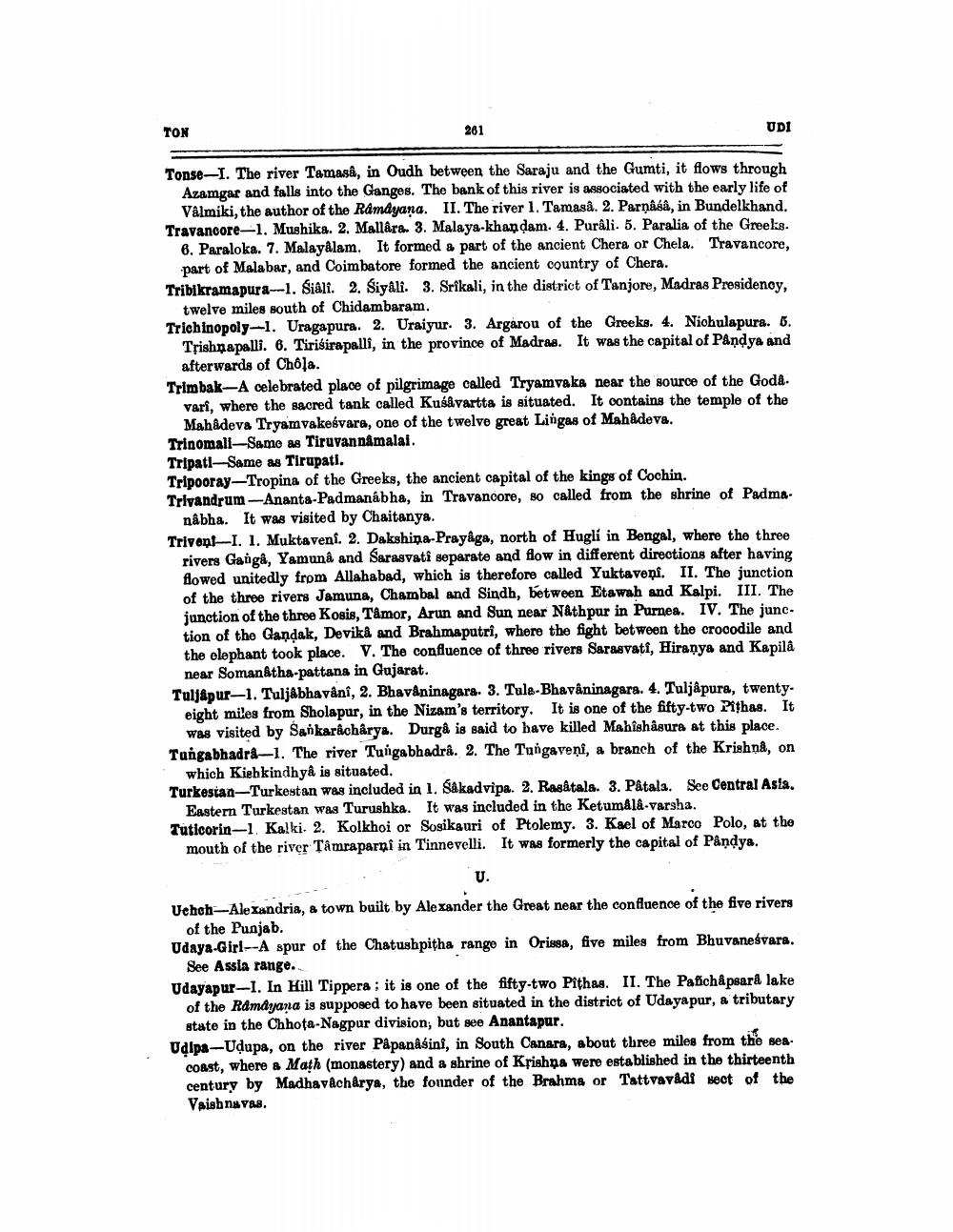________________
TON
261
UDI
Tonse-I. The river Tamasa, in Oudh between the Saraju and the Gumti, it flows through
Azamgar and falls into the Ganges. The bank of this river is associated with the early life of
Valmiki, the author of the Ramayana. II. The river 1. Tamaså. 2. Parnåsa, in Bundelkhand. Travancore-1. Mushika. 2. Mallara. 3. Malaya-khandam. 4. Purâli. 5. Paralia of the Greeks.
6. Paraloka. 7. Malayalam. It formed a part of the ancient Chera or Chela. Travancore,
part of Malabar, and Coimbatore formed the ancient country of Chera. Tribikramapura--1. Siali. 2. Siyali. 3. Srikali, in the district of Tanjore, Madras Presidenoy,
twelve miles south of Chidambaram. Trichinopoly-1. Uragapura. 2. Uraiyur. 3. Argarou of the Greeks. 4. Niohulapura. 6.
Trishnapalli. 6. Tirisirapalli, in the province of Madras. It was the capital of Påndya and afterwards of Chóla. Trimbak-A celebrated place of pilgrimage called Tryamvaka near the source of the Goda.
vari, where the sacred tank called Kuśåvartta is situated. It contains the temple of the
Mahadeva Tryamvakesvara, one of the twelve great Lingas of Mahadeva. Trinomall-Same as Tiruvannamalai. Tripati-Same as Tirupati. Tripooray-Tropina of the Greeks, the ancient capital of the kings of Cochin. Trivandrum - Ananta-Padmanabha, in Travancore, so called from the shrine of Padma
nâbha. It was visited by Chaitanya. Trivant-I. 1. Muktavenf. 2. Dakshina-Prayaga, north of Hugli in Bengal, where the three
rivers Gangå, Yamuna and Sarasvati separate and flow in different directions after having flowed unitedly from Allahabad, which is therefore called Yuktaveni. II. The junction of the three rivers Jamuna, Chambal and Sindh, between Etawah and Kalpi. III. The junction of the three Kosis, Támor, Arun and Sun near Nathpur in Purnea. IV. The junc. tion of the Gandak, Devikå and Brahmaputri, where the fight between the crocodile and the elephant took place. V. The confluence of three rivers Sarasvati, Hiranya and Kapila
near Soman&tha-pattans in Gujarat. Tuljapur-1. Tuljábhavani, 2. Bhavaninagara. 3. Tule-Bhavaninagara. 4. Tuljápura, twenty
eight miles from Sholapur, in the Nizam's territory. It is one of the fifty-two Pithas. It
wag visited by Sankaracharya. Durgå is said to have killed Mahishasura at this place. Tangabhadra-1. The river Tungabhadrâ. 2. The Tungaveni, a branch of the Krishna, on
which Kishkindhyâ is situated. Turkesian-Turkestan was included in 1. Sakadvipa. 2. Rasåtala. 3. Påtala. See Central Asia.
Eastern Turkestan was Turushka. It was included in the Ketumála-varsha. Tuticorin-1. Kalki. 2. Kolkhoi or Sosikauri of Ptolemy. 3. Kael of Marco Polo, at the
mouth of the river Tâmraparni in Tinnevelli. It was formerly the capital of Påndya.
Veheh-Alexandria, & town built by Alexander the Great near the confluence of the five rivers
of the Punjab. Udaya-Girl--A spur of the Chatushpitha range in Orissa, five miles from Bhuvanesvara.
See Assia range. Udayapur-I. In Hill Tippera ; it is one of the fifty-two Pithas. II. The Pafichåpsarà lake
of the Ramayana is supposed to have been situated in the district of Udayapur, a tributary
state in the Chhota-Nagpur division, but see Anantapur. Udlpa-Udupa, on the river Papanasini, in South Canara, about three miles from the sea
coast, where a Math (monastery) and a shrine of Krishna were established in the thirteenth century by Madhavacharya, the founder of the Brahma or Tattvavadi sect of the Vaishnavas.




